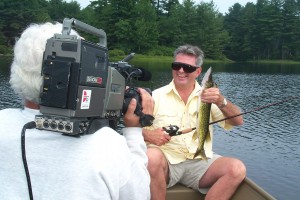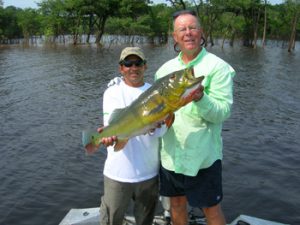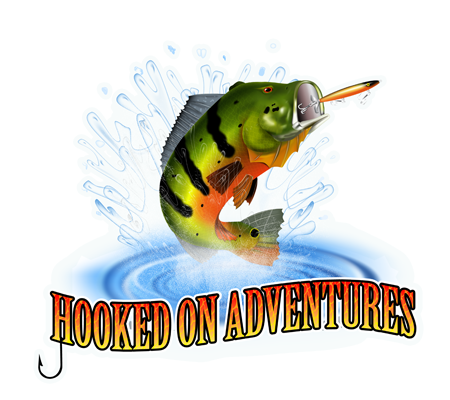 Note: This article about fishing on the Madeira River was originally published in The New York Times.
Note: This article about fishing on the Madeira River was originally published in The New York Times.
Original Article BY KEN SCHULTZ
This morning, the fourth on a week-long trip, Darrell Vore and I are headed up the Rio Igapo-açu, the “river of the big flooded forest” and a three-times-removed tributary to the mighty Madeira River. We are a twenty-five-hour boat ride from Autazes, the nearest city.
Igapo-açu is a term that could apply to a thousand tributaries here. Northern Brazil’s major rivers are the equivalent of America’s superhighways; its major tributaries are like our state highways; and its thousands of smaller tributaries and flooded passageways are like our county and small-town roads. It’s impossible to comprehend how vast this water world is without seeing and exploring it.
Our destination is a lakelike area in the midst of Cunhã Sapucia, an indigenous reserve where the only village, Tapajem, contains eighty-one residents who live in stilted thatched-hut housing and use hand-carved, low-to-the-water dugout canoes for transportation. The village chief has granted permission for us to catch and release fish, principally peacock bass, or tucunare, in the reserve.
Unrelated to the sundry popular species of North American bass, tucunare are the largest-growing member of the cichlid family of fish and an aggressive predator that can sometimes be seen chasing harried baitfish, especially long and slender sardinata, into the shallows and pinning them against the shore. They occasionally cause fleeing prey to skip across the surface like flyingfish, sometimes landing on the bank.
 Yesterday, in a large lakelike area about 20 miles away, Vore and I caught peacock bass until our arms and wrists were weary. None were large, however, so we vowed to use only big lures today and to concentrate on catching some of the huge specimens – fish in the 15- to 27-pound class – that draw several hundred avid anglers here each year during the dry and low-water season. Access to these areas is gained via a yachtlike shallow-draft mothership, the Amazon Santana, which tows its fishing boats behind, moving daily to new areas and allowing guests to eat and sleep in comfort each evening after spending a dawn-to-dusk day casting, catching, and profusely perspiring.
Yesterday, in a large lakelike area about 20 miles away, Vore and I caught peacock bass until our arms and wrists were weary. None were large, however, so we vowed to use only big lures today and to concentrate on catching some of the huge specimens – fish in the 15- to 27-pound class – that draw several hundred avid anglers here each year during the dry and low-water season. Access to these areas is gained via a yachtlike shallow-draft mothership, the Amazon Santana, which tows its fishing boats behind, moving daily to new areas and allowing guests to eat and sleep in comfort each evening after spending a dawn-to-dusk day casting, catching, and profusely perspiring.
At 6:30 we stopped to cast to the edge of a point of flooded trees, but left shortly after witnessing other predators at work. A pod of dolphins, which had surfaced behind us, swiftly came to the point and stampeded down the edge of trees chasing fish.
Freshwater porpoises, or dolphins, called botu, travel in pairs or small groups throughout the Amazon River and its tributaries. In prior days we observed dozens of them, or heard them puffing through blowholes. Amazonian natives say that botu, which exist entirely in freshwater, eat peacock bass among other fish, and that whenever dolphins are around, peacock bass move into the thickly tangled flooded rain forest to escape them. At this location, the dolphins seemed intent on doing their own bass catching.
Soon, at another point, Vore caught a 12-pound peacock bass, which our guide, Wilson Rodriguez de Lima, was unhooking when my large propellered surface lure, ripping across the surface, was stopped by a thunderous crash.
“Grande, grande,” shouted Rodriguez excitedly. Then, more softly, “ohhh, grande.”
As I held onto the hard-pulling fish, Rodriguez, who speaks as little English as I speak Portuguese, suggested that I be careful. “Easy,” he urged softly.
It’s unclear whether Rodriguez was telling himself to stay calm or me, but I was in a struggle. The worst that can happen is for a large powerful tucunare to turn and charge back into the flooded forest. Once there, the chances of landing it are remote, since the fish pulls the line around trees or snags the hooks on objects, in either case breaking free.
This peacock bass made two strong runs at the trees, getting within a whisker of them once, but I was able to steer it into the open and later direct it into an outstretched net. Wilson whooped and I stared for several moments at 20 pounds of gleaming yellow-green fish with orange-tinged fins and a mouth the size of a cantaloupe.
After the bass was unhooked and quickly photographed it was returned to the water, splashing the boat with a strong tail thrust while departing. Vore resumed fishing. Rodriguez performed tackle maintenance. I sat for a moment to wipe off perspiration, drink cold water, and reflect on my good fortune to start this day in such fashion, in so unique a place.
Shortly, Rodriguez brought the incongruity of his world and mine into focus.
“Where you live?” he asked, completely out of the blue.
“New York.”
“Near Miami?”
“No. Not near Miami. Not near grande tucunare either.”
“Hmm,” he murmured, nodding. “Too bad.”
By: Ken Schultz
Text & photos © 2011 Ken Schultz. All rights reserved. Re-use prohibited without written permission.

